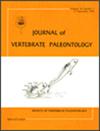First report of “Mammut” (Mammalia, Proboscidea) from the Upper Miocene of Turkey
IF 1.9
4区 地球科学
Q2 PALEONTOLOGY
引用次数: 0
Abstract
ABSTRACT Mammutidae comprise a proboscidean family that originated in Africa during the late Oligocene, dispersed across the Holarctic during the Miocene, and survived in North America until the end of the Pleistocene. Despite their long evolutionary history and wide geographic distribution mammutids are particularly scarce in the Miocene of Eurasia. Here, we present a new mammutid specimen (an upper deciduous premolar) from the Upper Miocene locality of Sazak in southwestern Turkey. Morphological and metric traits of the tooth, in particular the well-expressed zygodonty, are distinct from the more basal Zygolophodon and permit its assignment to the more derived “Mammut.” Due to the absence of more diagnostic specimens, a specific attribution is not possible; however, considering the Turolian age of the associated fauna an attribution to the Late Miocene representative of the genus, “Mammut” obliquelophus, is possible. Turolian mammutids are rare in the fossil record and therefore our knowledge remains only fragmentary. Despite the existence of a single specimen, the presence of this genus in Sazak corresponds to its first report in the Upper Miocene of Turkey, as well as the first one in western Asia. The presence of “Mammut” in the Upper Miocene of China was recently confirmed, and therefore the record of “Mammut” at Sazak, i.e., at the western margin of Asia, not only adds to the scanty record of the genus in the Upper Miocene of Eurasia but also provides another line of evidence of the paleozoogeographic link enabling Europe–East Asia proboscidean interchanges during the Late Miocene.土耳其中新世上部“猛犸象”(哺乳目,长鼻目)首次报告
本文章由计算机程序翻译,如有差异,请以英文原文为准。
求助全文
约1分钟内获得全文
求助全文
来源期刊
CiteScore
2.90
自引率
7.10%
发文量
58
审稿时长
4-8 weeks
期刊介绍:
The Journal of Vertebrate Paleontology publishes original contributions on all aspects of vertebrate paleobiology, including vertebrate origins, evolution, functional morphology, taxonomy, biostratigraphy, phylogenetics, paleoecology, paleobiogeography, and paleoanthropology. JVP publishes high quality peer-reviewed original articles, occasional reviews, and interdisciplinary papers. It is international in scope, and emphasizes both specimen- and field-based based research and the use of high-quality illustrations. Priority is given to articles dealing with topics of broad interest to the entire vertebrate paleontology community and to high-impact specialist studies. Articles dealing with narrower topics, including notes on taxonomic name changes (unless these deal with errors published in JVP), preliminary site reports, and documentation of new specimens of well-known taxa, are afforded lower priority.

 求助内容:
求助内容: 应助结果提醒方式:
应助结果提醒方式:


